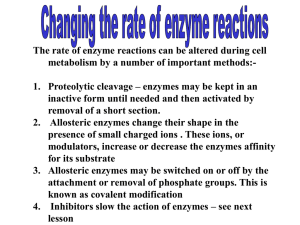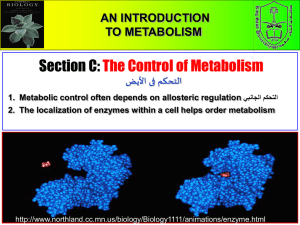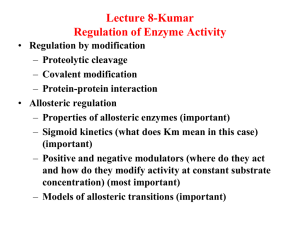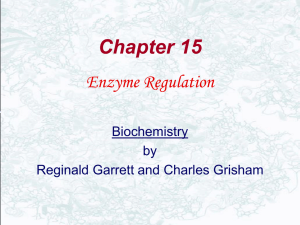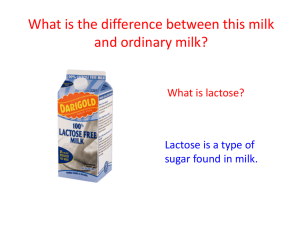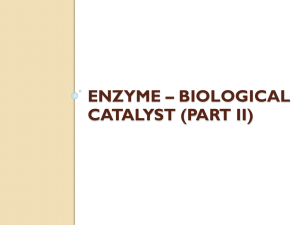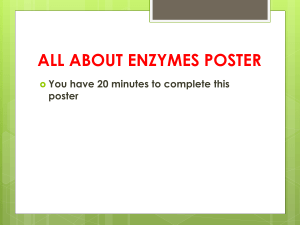Regulatory Strategies
advertisement
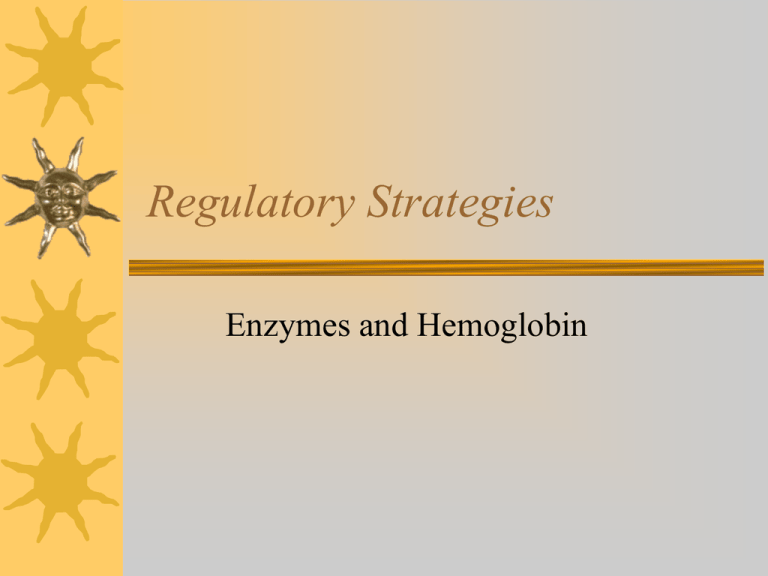
Regulatory Strategies Enzymes and Hemoglobin Regulatory Strategies What are the four ways in which enzymes are regulated? – – – – allosteric regulation enzymes exist in multiple forms (isoenzymes) covalent modification proteolytic cleavage Allosteric Regulation What are some of the characteristics of this form of regulation? – Activity influenced by non-covalent binding of metabolite called a modulator • May be inhibitory or stimulatory • May have one (monovalent) or several (polyvalent) modulators • Binding induces shape change in enzyme • Enzymes are large; two or more subunits • Exhibit homotropic or heterotropic control Allosteric Regulation – enzyme may be part of a sequence in which the end product inhibits allosteric enzyme – enzyme does not show Michaelis-Menten kinetics Aspartate Transcarbamoylase What is the reaction catalyzed by this enzyme? Aspartate Transcarbamoylase CTP is a negative modulator and ATP is a positive modulator – feedback inhibition Aspartate Transcarbamoylase How do we know that the catalytic and regulatory sites on this enzyme are distinct? – treat with p-hydroxymercuribenzoate Aspartate Transcarbamoylase Catalytic subunit consists of 3 chains (c3) and regulatory subunit consists of 2 chains (r2) Aspartate Transcarbamoylase Allosteric modulators alter the quaternary structure of the enzyme Aspartate Transcarbamoylase What is the difference between the T state and the R state of the enzyme? – T = tense; lower affinity for substrate – R = relaxed; higher affinity for substrate Binding of substrate or substrate analog converts enzyme from T to R state – positive cooperativity – homotropic control Aspartate Transcarbamoylase How does CTP act as a negative modulator? Why is this an example of heterotropic modulation? Aspartate Transcarbamoylase How does ATP act as a positive modulator? Does this represent homo or heterotropic modulation? Aspartate Transcarbamoylase Why is the mechanism just described called the concerted model? – All subunits must be in same conformation, T or R Allosteric Regulation An alternative, the sequential model has been proposed Allosteric Regulation How does the sequential model differ from the concerted model? – Subunits may undergo individual sequential changes in conformation – Subunits can interact even in different conformations – Change induced by binding of substrate to one subunits can increase or decrease substrate binding to other subunits • positive or negative homotropic effects • finer tuning Allostery and Hemoglobin Binding of O2 to hemoglobin represented by a sigmoidal curve similar to allosteric enzymes Cooperativity promotes efficient O2 delivery Allostery and Hemoglobin What part of the hemoglobin molecule binds O2? Allostery and Hemoglobin How does the binding of O2 affect the structure of heme? Allostery and Hemoglobin How does O2 binding influence the quaternary structure of hemoglobin? Allostery and Hemoglobin How does 2,3 bisphosphoglycerate affect O2 affinity of hemoglobin? How is this effect brought about? Allostery and Hemoglobin How is fetal hemoglobin different from maternal hemoglobin? How can this be explained? Allostery and Hemoglobin What is the Bohr effect? What is the chemical basis of this effect? Allostery and Hemoglobin CO2 also stabilizes deoxyhemoglobin by forming carbamate groups Isozymes What are isozymes or isoenzymes? – enzymes that have differences in amino acid sequence but catalyze the same reaction • Example – lactate dehydrogenase • Two different chains, M and H, exist • Enzyme consists of 4 subunits – H4, H3M, H2M2, HM3, M4 • Each form has different Km and Vmax Isozymes M4 functions best in anaerobic environment while H4 in aerobic environment Covalent Modification Enzymes exist in active and inactive forms – Interconvertable by covalent modification • Catalyzed by other enzymes • Most modifications are reversible Covalent Modification Covalent Modification What are the most common forms of covalent modification? – Phosphorylation and dephosphorylation Which enzymes catalyze phosphorylation? – protein kinases Which enzymes catalyze dephosphorylation? – protein phosphatases Covalent Modification What donates the phosphate group? Covalent Modification Why is phosphorylation an effective way to regulate proteins? – – – – – – Phosphate group adds negative charges Phosphate group can form hydrogen bonds Free energy of phosphorylation is large Can occur rapidly or slowly as needed Can achieve amplification Linked to energy status of cell Covalent Modification Example – glycogen phosphorylase – Two forms a and b • A = active; 4 subunits each with a serine residue phosphorylated at OH group • B = inactive; removal of PO4 groups causes protein to separate into two half molecules Covalent Modification What is the connection between c-AMP and protein kinases? – PKA activated by c-AMP in cells Zymogens What are zymogens? – inactive precursors of enzymes How are they activated? – proteolytic cleavage Zymogens Zymogens What are some other examples? – Blood clotting – Insulin – Conversion of procollagenase to collaginase in metamorphosis – Conversion of procaspases to caspases in apoptosis Zymogens Activation of chymotrypsinogen to chymotrypsin Zymogens Why is trypsin a key enzyme in zymogen activation? Zymogens Why do proteolytic enzymes have specific inhibitors? – To prevent premature activation of the enzyme – Activation of trypsin in pancreas could destroy pancreatic tissue Zymogens How are zymogens involved in the formation of blood clots?
